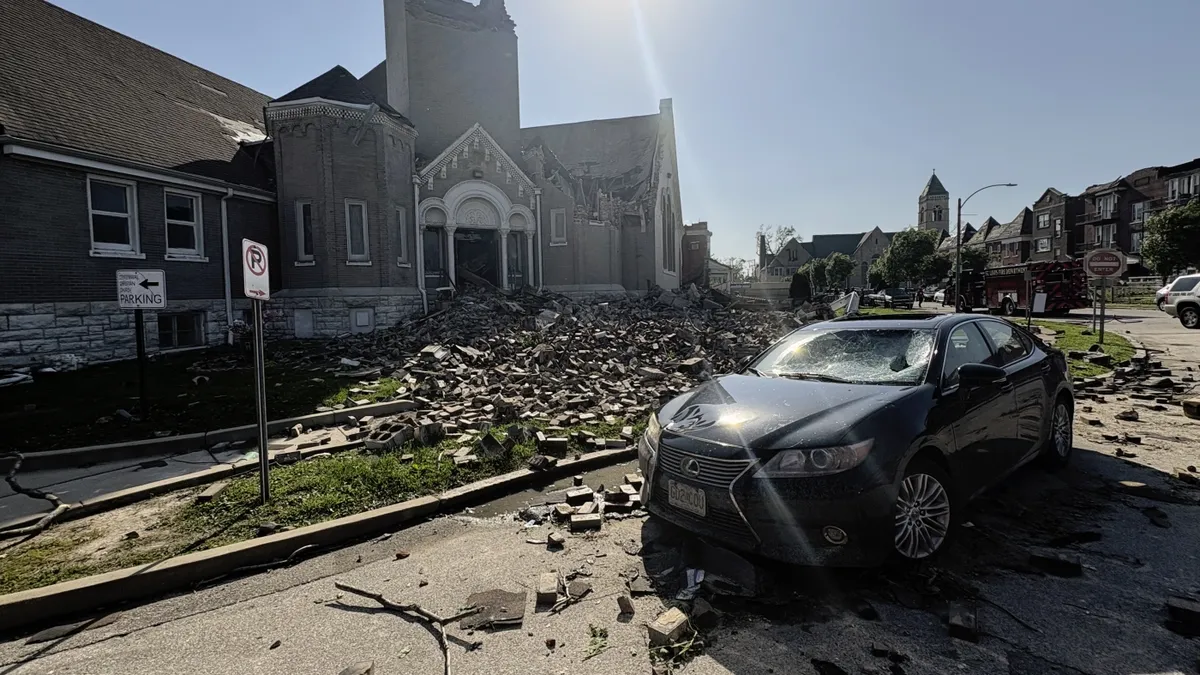
Authorities are conducting extensive searches through buildings in Missouri as the aftermath of severe storms, including a possible tornado, has left at least seven people dead. The storms are part of a larger weather system that struck on Friday, causing destruction across Missouri, spawning tornadoes in Wisconsin, and leaving hundreds of thousands without power in the Great Lakes region. Additionally, a punishing heat wave has settled over Texas, exacerbating the situation.
In St. Louis, Mayor Cara Spencer confirmed five fatalities and reported that more than 5,000 homes were affected by the severe weather. Approximately 100,000 customers were left without electricity as of Friday night. "This is truly devastating," Spencer stated, indicating that the city was in the process of declaring a state of emergency. An overnight curfew was also imposed in the neighborhoods hardest hit by the storms.
The number of injuries remains uncertain, but Barnes-Jewish Hospital reported receiving between 20 to 30 patients, with some in serious condition; however, most were expected to be discharged by Friday night. Meanwhile, St. Louis Children’s Hospital treated 15 patients, with two expected to remain hospitalized over the weekend.
According to the National Weather Service radar, a tornado touched down in Clayton, Missouri, between 2:30 p.m. and 2:50 p.m. This area includes Forest Park, home to the St. Louis Zoo and the location of the 1904 World's Fair and Olympic Games. The storm caused significant structural damage, including reports of roofs being torn off buildings, windows being blown out, and trees and power lines being uprooted.
At Centennial Christian Church, three individuals needed rescue when part of the church collapsed; one of the victims was identified as Patricia Penelton, remembered as an active church volunteer. Witnesses reported chaotic scenes as winds intensified and power outages occurred suddenly, leaving residents scrambling for safety.
Traffic gridlock ensued as downed trees and traffic lights obstructed roads during the Friday afternoon commute, prompting officials to advise residents to stay home. The upper stories of the Harlem Taproom were completely demolished, but thankfully, the 20 patrons inside took shelter in the back and remained unharmed.
Many individuals experienced frightening moments during the storm. John Randle, a 19-year-old student, described being rushed into the basement of the St. Louis Art Museum along with about 150 others, where they listened to the storm's fury outside. Meanwhile, Christy Childs, a spokesperson for the St. Louis Zoo, confirmed that all animals were safe, although the zoo would remain closed on Saturday due to storm damage.
The severe weather system did not only impact Missouri; it also caused fatalities in Scott County, approximately 130 miles south of St. Louis, where two people died, and several homes were destroyed due to a tornado. Sheriff Derick Wheetley praised first responders for their bravery in providing immediate assistance, even as the tornado remained active.
Weather forecasters warned that severe storms with potential for tornadoes, hail, and hurricane-force winds could affect parts of Appalachia and the Midwest. A rare tornado emergency was declared around Marion, Illinois, where a confirmed tornado posed a life-threatening risk. The National Weather Service advised residents in Kentucky, southern Indiana, southern Illinois, parts of Tennessee, Missouri, Arkansas, and Ohio to prepare for intense storms, including the possibility of baseball-sized hail.
As the Midwest faced severe storms, Texas dealt with a blistering heat wave. A heat advisory was issued for San Antonio and Austin, with temperatures soaring between 95°F (35°C) and 105°F (40.5°C). The National Weather Service cautioned that humidity levels were expected to rise, making conditions feel even hotter and increasing the risk of heat exhaustion.
Overnight storms on Thursday brought thunder, lightning, and powerful winds to parts of Wisconsin, Illinois, northern Indiana, and Michigan. Reports of extensive damage, including downed trees and power outages, are still being assessed. In Michigan, nearly 190,000 customers were without power as restoration efforts continued. Meteorologists noted that the storms were fueled by warm temperatures in the lower 80s Fahrenheit (26-29°C) and were activated by a cold front.
As the region braces for more severe weather, residents are reminded to stay informed and prepared for potential emergencies in the coming days.